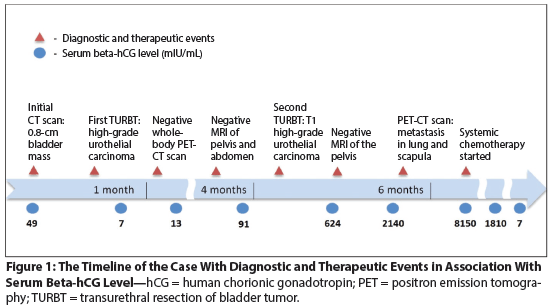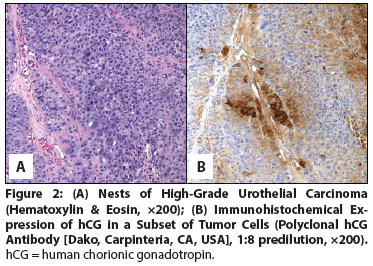The Use of Serum hCG as a Marker of Tumor Progression and of the Response of Metastatic Urothelial Cancer to Systemic Chemotherapy
A 55-year-old woman with a history of metastatic melanoma in remission for 8 years presented to the emergency department with gross hematuria. A CT scan, ordered because the patient was in menopause, demonstrated a bladder tumor.
Figure 1: The Timeline of the Case With Diagnostic and Therapeutic Events in Association With Serum Beta-hCG Level

Figure 2: (A) Nests of High-Grade Urothelial Carcinoma (Hematoxylin & Eosin, ×200); (B) Immunohistochemical Expression of hCG in a Subset of Tumor Cells (Polyclonal hCG Antibody [Dako, Carpinteria, CA, USA], 1:8 predilution, ×200).

The Case:A 55-year-old woman with a history of metastatic melanoma in remission for 8 years presented to the emergency department with gross hematuria. A serum beta–human chorionic gonadotropin (beta-hCG) measurement was ordered prior to a planned CT scan, and showed a mildly elevated level of 49 mIU/mL. The CT scan, ordered because the patient was in menopause, demonstrated a bladder tumor. A transurethral resection (TURBT) of the 1-cm solid-appearing mass on the stalk on the posterior bladder wall was later performed, followed by intravesical immunotherapy with Bacillus Calmette-Guérin (BCG). The pathology report confirmed minimally invasive high-grade urothelial cell carcinoma without muscularis propria involvement (T1 tumor). A repeat cystoscopy within 3 months showed recurrence of disease, with a 1-cm solid-appearing sessile mass on the stalk at almost the exact position of the previously resected tumor. A second TURBT was performed, and pathology again revealed a stage T1 high-grade papillary urothelial carcinoma.
The patient was followed by her gynecologist with serial hCG levels (Figure 1). Because of the elevated beta-hCG level, immunohistochemical analysis of the tumor for hCG was performed and demonstrated focal positive immuno-staining of cells in both the patient’s primary and recurrent bladder tumors (Figure 2). Restaging scans of the abdomen and pelvis were obtained and showed no evidence of recurrent or metastatic disease. A subsequent serum beta-hCG test, performed a month later, showed a level of 2,140 mIU/mL. A whole-body PET (positron emission tomography)-CT scan revealed multiple new fluorodeoxyglucose (FDG)-avid lung lesions and a right scapular lesion, consistent with metastatic disease. Wedge resection of the lung nodules demonstrated high-grade urothelial carcinoma, similar to the first primary tumor, with focal positive immunoreactivity for hCG. A PET-CT scan performed 3 months earlier as part of her melanoma follow-up, and after the first TURBT, had been completely negative.
The patient started systemic chemotherapy with gemcitabine and cisplatin. The pretreatment beta-hCG level was 8,150 mIU/mL. The serum hCG level decreased to 1,810 mIU/mL after the first cycle and to 7 mIU/mL after the third cycle of chemotherapy. Repeat imaging showed improvement of lung nodules. The patient is continuing chemotherapy with gemcitabine and cisplatin.
Discussion
Ectopic production of gonadotropin by bladder tumor was first described in 1904.[1] More sensitive beta-hCG assays have led to an increased number of reported cases.[2] An early immunohistochemical study revealed that 36% of all cases of transitional cell carcinoma of the bladder stained positive for hCG.[3] A higher rate of expression was found in the invasive stages of the disease (Ta: 24%; T2–4: 63%), as well as in more poorly differentiated tumors (G1: 26%; G3: 55%). In another smaller study, 100% of patients (5 out of 5) with metastatic disease had positive results of tissue analysis for hCG.[4]
Focal expression of beta-hCG can result in false-negative immunohistochemical stains due to sampling errors. However, detection of beta-hCG in blood or urine may lead to a reduction of false-negative expression. According to one review, in patients with bladder cancer, an elevated level of beta-hCG was found in 76% and 73%, for serum and urine samples, respectively.[5] A small study by Iles and colleagues[6] demonstrated good correlation of a positive beta-hCG test with the radiographic presence of metastatic disease (predictive value of 89%), using a cut-off for beta-hCG level in the serum of 25 mIU/mL.
In our patient, the initial serum level of beta-hCG was 49 mIU/mL. This decreased to 7 mIU/mL immediately after the TURBT of a primary diagnosed bladder tumor. This could have represented localized disease at that time. However, there is a high level of “understaging” of risk with morphologic assay of classic TURBT biopsies in non–muscle-invasive cancer. According to some authors, in up to 40% of TaT1 cases, a second-look TURBT or consecutive cystectomy showed evidence of invasion of tumor to the muscularis propria.[7] In general, it is sometimes extremely difficult to distinguish between T1 and T2 (muscle-invasive) disease, but it is important to remember that about 85% of patients who develop a muscle-invasive disease do not have a history of bladder tumor confined to the mucosal and submucosal layers. Also, in clinical practice the time between stage T1 and clinical progression to T2–4 is about 2 years.[8] The use of a serum marker such as beta-hCG can potentially help with early identification of patients with a high risk of muscle-invasive or metastatic disease. Unfortunately, the lack of an initial chest CT scan in our case makes it difficult to know whether lung metastases were present at that time. The fact that the serum hCG level did not decrease, but rose dramati- cally after the second TURBT, makes the presence of metastatic foci at that time very likely.
In this patient, declines in the beta-hCG level correlated with radiographic response to gemcitabine/cisplatin chemotherapy. A similar observation has been made previously[9]: In patients with chemotherapy-resistant disease, the level of hCG rose, while in cases of clinical response, the level of hCG steadily decreased. Larger studies of beta-hCG declines and elevations as correlates of response and survival are warranted.
Although the biological role of beta-hCG in urothelial cancer growth and progression is unclear, in vitro administration of beta-hCG to different urothelial carcinoma cell lines demonstrates dose-dependent growth stimulation.[10] Co-incubation of these cell lines with anti–beta-hCG antisera inhibits the stimulatory effect of beta-hCG. Based on these preclinical data, an anti-hCG vaccine has been developed and currently is being studied in neoadjuvant and adjuvant settings, in patients who have locally advanced urothelial cancer.
Summary
This case confirms the observation that urothelial carcinomas can secrete beta-hCG, and that beta-hCG can potentially be used as a marker of a patient’s clinical response to treatment. Prospective studies are clearly warranted by these observations.
Disclosures:
Dr. Petrylak has served as a consultant to Bayer, Bellicum, Dendreon, Exelixis, Ferring, Johnson & Johnson, Millennium, Medivation, Pfizer, and Sanofi Aventis; he has received grant support from Celgene, Dendreon, Johnson & Johnson, Millennium, Progenics, and Oncogenix. The rest of the authors have no significant financial interest or other relationship with the manufacturers of any products or providers of any service mentioned in this article.
References:
1. Djewitzi W. Ãbereinen fall von chorionepithelioma der harnblase. Virchows Arch. 1904;178:451-64.
2. Iles RK, Butler SA. Human urothelial carcinomas-a typical disease of the aged: the clinical utility of human chorionic gonadotrophin in patient management and future therapy. Exp Gerontol. 1998;33:379-91.
3. Dirnhofer S, Koessler P, Ensinger C, et al. Production of trophoblastic hormones by transitional cell carcinoma of the bladder: association to tumor stage and grade. Hum Pathol. 1998;29:377-82.
4. Moutzouris G, Yannopoulos D, Barbatis C, et al. Is beta-human chorionic gonadotrophin production by transitional cell carcinoma of the bladder a marker of aggressive disease and resistance to radiotherapy? Br J Urol. 1993;72:907-9.
5. Cole LA, Butler SA. Human chorionic gonadotropin. London: Elsevier; 2010.
6. Iles RK, Jenkins BJ, Oliver RT, et al. Beta human chorionic gonadotrophin in serum and urine. A marker for metastatic urothelial cancer. Br J Urol. 1989;64:241-4.
7. Dutta SC, Smith JA, Jr, Shappell SB, et al. Clinical understaging of high risk nonmuscle invasive urothelial carcinoma treated with radical cystectomy. J Urol. 2001;166:490-3.
8. Hidas G, Pode D, Shapiro A, et al. The natural history of secondary muscle-invasive bladder cancer. BMC Urol. 2013;8:13-23.
9. Mora J, Gascón N, Tabernero JM, et al. Different hCG assays to measure ectopic hCG secretion in bladder carcinoma patients. Br J Cancer. 1996;74:1081-4.
10. Gillott DJ, lles RK, Chard T. The effects of beta-human chorionic gonadotrophin on the in vitro growth of bladder cancer cell lines. Br J Cancer. 1996;73:323-6.